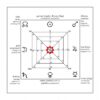Drekkana reckoning and Rishis
Yashoda annd Swati’s question wrote:
Hare Rama Krsna, I was listening to Atri classes on Jagannatha drekkana , where Sanjayji talks about Agasthya is related to Bhramarishi ( chara rashis, 9th from sthir rashis Moon ), Doorvaasa is related to Maharishi (sthira rashis, 9th from dwija rashis Moon), Narada is connected to devarishi (dwija rashis, 9th from chara rashis Moon)
In contrast to this, in the narayana dasha book, it is given other way round, as Agasthya related to Maharishi (sthira rashis) and Doorvaasa is related to Bhramarishi (chara rashis).
Spirituality in Jyotish
The heart lotus – basics of spirituality and aṣṭamaṅgalam; Also Iṣṭa devatā, pālana devatā and Guru devatā.
Not concerning ourselves with the inanimate world, let us focus on the living beings, and that too the human being and spirituality. The aṣṭadala padma (eight-petal lotus) is the foundation of Hindu philosophy. It is based on the Kālachakra or the wheel of time, which is composed of eight spokes and has the 28 constellations distributed in these spokes.
National Finance
Introduction- The houses
Before venturing into the study of the finances of a nation we should be clear about the indications of the houses in the chart.
In deva prasna (i.e. questions bearing on deities, the twelve houses signify (1) Divine presence, (2) wealth, (3) temple servants, (4) vehicles (5) image, idol, picture or symbol like an alter, (6) enemies, (7) ornaments, (8) offerings, oblations of five or sixteen kinds, (9) temple authorities, (10) festivals, (11) income and (12) expenditure.
Trimsamsa D-30 Chart
There are two methods to draw a Trimsamsa (D30) Chart. We discuss the method of Parashara.
What is the Trimsamsa, and how to draw a Trimsamsa Chart?
Trimsamsa means the one-thirtieth portion of a sign measuring one degree. Unlike other divisions, the Sun and Moon are not the Lords of any trimsamsa and the Nodes (Rahu & Ketu) also do not owm any trimsamsa. Thus the remaining five of Mars, Mercury, Jupiter, Venus and Saturn own the trimsamsa.












 DBC offers online courses in jyotish (Vedic Astrology) taught directly by Sanjay Rath as per the tradition, through narrated power points and other audio tools. The courses are at different levels, from the beginners through the intermediate to the advanced and are known as SoHamsa | DBC courses, with individual classrooms and assistant teachers
DBC offers online courses in jyotish (Vedic Astrology) taught directly by Sanjay Rath as per the tradition, through narrated power points and other audio tools. The courses are at different levels, from the beginners through the intermediate to the advanced and are known as SoHamsa | DBC courses, with individual classrooms and assistant teachers
 Sagittarius Publications is the publisher and distributor the popular quaterly magazine the Jyotish Digest, as well as many thorough books on the subject of Vedic Astrology or Jyotish.
Sagittarius Publications is the publisher and distributor the popular quaterly magazine the Jyotish Digest, as well as many thorough books on the subject of Vedic Astrology or Jyotish. We have an excellent pandit Divākar ‘Deva’ Mishra, who is from the priests of Vindhyāvāsini Siddha Pīṭha to guide you through the hundreds of temples of Kāśi [Varanasi] and neighbouring regions. He can organise your pūjā, keep you safe and take care. He is supported by an English-speaking well-travelled spouse ‘Supriya Mishra’. Please contact them directly for any services, remedial pūjā and tours. They handled the 60+ member Kāśi Jyotiṣa Group 2022.
We have an excellent pandit Divākar ‘Deva’ Mishra, who is from the priests of Vindhyāvāsini Siddha Pīṭha to guide you through the hundreds of temples of Kāśi [Varanasi] and neighbouring regions. He can organise your pūjā, keep you safe and take care. He is supported by an English-speaking well-travelled spouse ‘Supriya Mishra’. Please contact them directly for any services, remedial pūjā and tours. They handled the 60+ member Kāśi Jyotiṣa Group 2022.